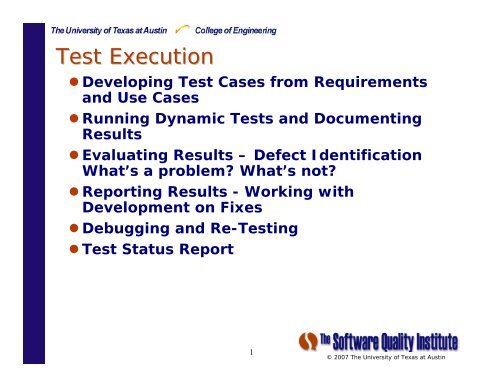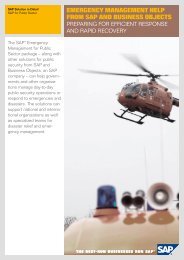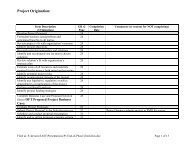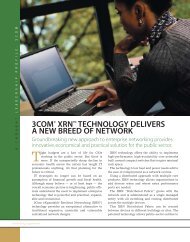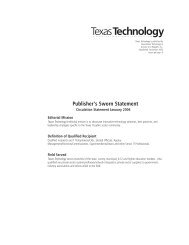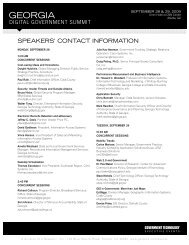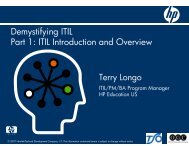P15 Acceptance - Test Execution
P15 Acceptance - Test Execution
P15 Acceptance - Test Execution
Create successful ePaper yourself
Turn your PDF publications into a flip-book with our unique Google optimized e-Paper software.
<strong>Test</strong> <strong>Execution</strong><br />
Developing <strong>Test</strong> Cases from Requirements<br />
and Use Cases<br />
Running Dynamic <strong>Test</strong>s and Documenting<br />
Results<br />
Evaluating Results – Defect Identification<br />
What’s a problem? What’s not?<br />
Reporting Results - Working with<br />
Development on Fixes<br />
Debugging and Re-<strong>Test</strong>ing<br />
<strong>Test</strong> Status Report<br />
1<br />
© 2007 The University of Texas at Austin
Dynamic <strong>Test</strong>ing<br />
Exercising the software code on a computer<br />
system to see if it performs according to<br />
the specifications and requirements<br />
Will the software perform accurately,<br />
reliably and consistently when released<br />
for business use?<br />
Discover and repair as many defects as<br />
possible prior to release<br />
“A “A successful test test is is one one<br />
that that finds finds an an error.”<br />
-GlenfordMyers<br />
2<br />
© 2007 The University of Texas at Austin
Dynamic <strong>Test</strong>ing<br />
Quality cannot be<br />
tested-in<br />
No amount of testing<br />
can prove that a defect<br />
does not exist<br />
<strong>Test</strong>ing is expensive –<br />
balance the cost with<br />
the returns<br />
<strong>Test</strong> ‘smart’ – consider:<br />
Complexity<br />
Risk<br />
Expected Usage<br />
3<br />
“<strong>Test</strong>ing<br />
cannot show show<br />
us us the the absence<br />
of of defects…<br />
it it can can only only<br />
show show us us that that<br />
defects are are<br />
present.”<br />
-Robert<br />
Pressman<br />
© 2007 The University of Texas at Austin
The V-Shaped V Shaped Model for V&V<br />
Emphasis on verification and validation ‘as you go’<br />
Business Rqmts<br />
Software Rqmts<br />
Software Design<br />
Code Unit <strong>Test</strong><br />
Developers and other IT staff will perform many<br />
tests as the software is developed<br />
Unit testing is done during code development<br />
Integration testing is done as components are<br />
assembled according to the design<br />
4<br />
Integration <strong>Test</strong><br />
<strong>Acceptance</strong> <strong>Test</strong><br />
System <strong>Test</strong><br />
Developer<br />
<strong>Test</strong>ing<br />
© 2007 The University of Texas at Austin<br />
User<br />
<strong>Test</strong>ing
Developer <strong>Test</strong>s<br />
White box testing based on knowledge of the<br />
internal logic of the code<br />
Unit testing is the smallest scale of testing - done<br />
on the module level before the user interface is<br />
developed<br />
<strong>Test</strong>s that analyze the code statements, branches,<br />
paths and conditions for:<br />
Technical accuracy<br />
Standards<br />
Data integrity and structure<br />
Logic<br />
Compatibility<br />
Internal communications and connections<br />
Users may want to be informed about the results of<br />
previous testing efforts in terms of:<br />
Complexity<br />
Previous ‘hot’ spots<br />
5<br />
© 2007 The University of Texas at Austin
System <strong>Test</strong>s<br />
System <strong>Test</strong>s<br />
Black-box testing is done through the user<br />
interface without regard to the internal<br />
working of the software<br />
End-to-end testing once all components are<br />
assembled and placed in a executable<br />
environment (configuration and compatibility<br />
tests)<br />
Performance or stress testing – tests the<br />
performance at peak loads<br />
Installation testing – tests the process for<br />
installing, upgrading or uninstalling the<br />
software<br />
Recovery testing – tests software behavior<br />
during an unexpected interruption and it’s<br />
recovery for such an event<br />
Security testing – how well the software<br />
protects against unauthorized use and threats<br />
6<br />
© 2007 The University of Texas at Austin
System <strong>Test</strong> Cases<br />
Are designed to find conditions that could<br />
cause the software to fail or produce<br />
unexpected results<br />
<strong>Test</strong> both functional and non-functional<br />
requirements<br />
Some system test cases should be completed<br />
before involving users – to shake out all the<br />
obvious defects - sometimes known as sanity<br />
or smoke testing.<br />
Includes both positive and negative test cases<br />
Positive – does the software do what it’s<br />
supposed to do?<br />
Negative – does the software not do what<br />
it’s not supposed to do?<br />
7<br />
© 2007 The University of Texas at Austin
User <strong>Test</strong>ing<br />
System <strong>Test</strong>ing – generally done by IT or QA<br />
testers but users may be involved<br />
Usability <strong>Test</strong>ing – includes users performing<br />
normal tasks using the software and<br />
usability specialists recording observations<br />
Note: Users should review the results of<br />
system and usability testing<br />
<strong>Acceptance</strong> <strong>Test</strong>ing – is done by the users<br />
but may also be performed by an<br />
independent test group. May include:<br />
Alpha testing – in a test environment<br />
Beta – in the user’s environment<br />
Parallel <strong>Test</strong>ing – running the new software<br />
simultaneously with the existing software<br />
8<br />
© 2007 The University of Texas at Austin
Combined System/<strong>Acceptance</strong> <strong>Test</strong>ing<br />
To achieve schedule compression<br />
May improve communication between<br />
development staff and users<br />
Beneficial when users have little or no<br />
experience testing<br />
Users should be treated as<br />
‘partners’ in the process.<br />
Participate in and approve<br />
test plan, test cases and test<br />
results<br />
User’s should avoid ‘rush to judgment’.<br />
Defects are expected during testing, the<br />
full-picture will not be known until later<br />
in the process<br />
9<br />
© 2007 The University of Texas at Austin
Usability <strong>Test</strong>s<br />
Usability <strong>Test</strong>s<br />
Subjective tests designed to measure user<br />
friendliness from the user’s point of view<br />
Understandability<br />
Learn-ability<br />
Communicativeness<br />
Techniques<br />
Interviews<br />
Surveys<br />
Observations<br />
May test any aspect of use including<br />
Ergonomics/comfort<br />
Screen design<br />
ADA accommodation<br />
10<br />
© 2007 The University of Texas at Austin
<strong>Acceptance</strong> <strong>Test</strong> Cases<br />
Designed to test conditions<br />
by which users can<br />
determine if the software<br />
meets the requirements<br />
At least one test case per<br />
user requirement<br />
One use case = multiple<br />
test cases<br />
More positive test cases or<br />
‘Happy Path’ tests than<br />
negative test cases<br />
Based on user interactions<br />
with the system as<br />
specified in use cases, user<br />
scenarios, and user<br />
requirements<br />
11<br />
“There is is only<br />
one rule in in<br />
designing test<br />
cases:<br />
cover all all<br />
features, but but do do<br />
not not make too too<br />
many test cases”<br />
-Tsuneo -Tsuneo Yamaura Yamaura<br />
© 2007 The University of Texas at Austin
<strong>Acceptance</strong> <strong>Test</strong> Cases – how many?<br />
Enough to confirm the software can be<br />
implemented<br />
Prioritized requirements should drive testing<br />
<strong>Test</strong> the riskiest areas of the software fully<br />
<strong>Test</strong> the features or functions that are the<br />
key elements of the business process<br />
Idenfity the most complex requirements<br />
Find out where the problem spots are<br />
Ensuring coverage using traceability matrix<br />
Run tests on all functions (requirement<br />
sets or use cases)<br />
12<br />
© 2007 The University of Texas at Austin
What does a test case look like?<br />
<strong>Test</strong> Case Identifier<br />
<strong>Test</strong> Case Name<br />
<strong>Test</strong> Objective<br />
<strong>Test</strong> Item - what’s being tested<br />
Set up instructions are the preconditions as<br />
specified in the use case<br />
Data input requirements – the values and<br />
corresponding fields for entry, tolerances,<br />
value ranges, etc.<br />
Procedural requirements the exact<br />
sequence of steps to be followed<br />
Expected results are the post conditions as<br />
specified in the use case<br />
13<br />
© 2007 The University of Texas at Austin
<strong>Test</strong> Case Example<br />
<strong>Test</strong> Case 4.3.3 V. 1.0 <strong>Test</strong>er:<br />
Display Maternity Patient Summary <strong>Test</strong> Date:<br />
Objective: <strong>Test</strong> the function that allows the user to search, select<br />
and display maternity patient summaries using patient name.<br />
Summary includes patient name, ID, address/phone, age,<br />
number of previous pregnancies, live births, pregnancy status,<br />
due date or delivery date, applicable diagnosis codes and Rx’s.<br />
Verify that the data is displayed as expected.<br />
<strong>Test</strong> Description: <strong>Test</strong> will use data extracted from the current<br />
database. The results of searches will be displayed on the new<br />
user interface and will include up to 10 diagnosis codes and up<br />
to 20 Rx summaries.<br />
<strong>Test</strong> Conditions: The database will be loaded with all patient<br />
records as of 12/31/2005. All database records have been<br />
validated and are accurate. Records must have several patients<br />
with same last name.<br />
14<br />
© 2007 The University of Texas at Austin
<strong>Test</strong> Case Example<br />
Steps:<br />
1)Enter a valid last and first name from the list, select search<br />
1.1 Validate information displayed against report<br />
2)Enter a name not on the list, select search<br />
2.1 Validate message “error – patient not found”<br />
3)Enter a valid last name from the list that appears multiple times,<br />
select search<br />
3.1 Validate patient’s listed are all the patients with the last name<br />
3.2 Validate that no patients are included that should not be<br />
4)Select patients from the list<br />
4.1 Validate that information displayed to printed report<br />
…<br />
Post Conditions: No data will be changed or modified by this test.<br />
Expected Results: A paper report from the current system as of<br />
12/31/2005 is attached for verification.<br />
<strong>Test</strong> Case Result: Pass _____ Fail_____<br />
15<br />
© 2007 The University of Texas at Austin
Finding Additional <strong>Test</strong> Cases<br />
Create additional test cases for alternate<br />
courses<br />
Plan some guerrilla test cases based on the<br />
nastiest, most unusual, business situations<br />
that can be thought up. The test may<br />
include:<br />
extreme boundary tests,<br />
strange error conditions,<br />
unusual values in complex algorithms and<br />
computations,<br />
non-standard process flow<br />
Exploratory testing: Allow different testers to<br />
test the use case, generating tests on the fly<br />
16<br />
© 2007 The University of Texas at Austin
a<br />
s<br />
t<br />
i<br />
s<br />
e<br />
ld<br />
Traceability Matrix<br />
ID<br />
UC-1<br />
UC-1<br />
UC-1<br />
UC-1<br />
UC-2<br />
UC-2<br />
UC-2<br />
UC-3<br />
UC-3<br />
Use Case<br />
Req ID<br />
R1<br />
R2<br />
R3<br />
ER-1<br />
R1<br />
R2-1<br />
R2-2<br />
R1<br />
R2<br />
P<br />
P<br />
P<br />
UTC-1<br />
P=Pass I=Incomplete<br />
F=Fail X=Not tested<br />
P<br />
17<br />
UTC-2<br />
<strong>Test</strong> Case ID<br />
F<br />
UTC-4<br />
I<br />
I<br />
UTC-5<br />
X<br />
X<br />
© 2007 The University of Texas at Austin<br />
UTC-6
Before <strong>Test</strong>ing<br />
Have all requirements been reviewed and<br />
approved including changes?<br />
Have test criteria for requirements/use cases<br />
been developed?<br />
Has the test plan been developed, reviewed<br />
and approved including acceptance criteria?<br />
Are test cases written, traceability matrix<br />
complete? Have they been reviewed and<br />
approved?<br />
Are resources available and appropriately<br />
trained?<br />
Has the test environment been established<br />
including test data?<br />
Have supporting test tools been established<br />
for recording and reporting test results?<br />
18<br />
© 2007 The University of Texas at Austin
Documenting <strong>Test</strong> Case Results<br />
Evaluate test results<br />
Pass – the test results match the expected<br />
results<br />
Fail – the test results do not match the<br />
expected results<br />
When a test fails:<br />
Be sure it’s the software and not the test<br />
design at fault<br />
Review the data inputs are correct<br />
Rerun the test, if necessary<br />
Document results by recording<br />
When the test took place<br />
Pass/Fail<br />
19<br />
© 2007 The University of Texas at Austin
Managing <strong>Test</strong> Documentation<br />
Careful documentation standards including<br />
version control may be necessary on test cases<br />
to avoid repeating mistakes<br />
Establish a problem reporting system and<br />
process that records and tracks any event that<br />
requires investigation<br />
Keep a test log to record the status of all test<br />
cases and test cycles (hint: you can use the<br />
traceability matrix)<br />
<strong>Test</strong> status reports – regular summaries to<br />
management on testing activities, issues and<br />
metrics<br />
20<br />
© 2007 The University of Texas at Austin
Problem Reporting System<br />
Identify the test case, tester and test date<br />
Document actual results including screen prints<br />
and error messages<br />
Steps to reproduce the defect<br />
<strong>Test</strong>er’s assessment of defect severity<br />
Severe - Data loss, safety risk, or loss of major<br />
business functionality without workaround<br />
Moderate – Some loss of business functionality<br />
with workaround<br />
Minor - Cosmetic error<br />
<strong>Test</strong>er’s assessment of fix priority<br />
1. Must fix before release<br />
2. May be okay to release before fixed<br />
3. Fix when possible<br />
21<br />
© 2007 The University of Texas at Austin
Confirm <strong>Test</strong>ing Results<br />
Review and analyze defect reports to<br />
confirm tester’s assessment<br />
Preliminary review by <strong>Acceptance</strong> <strong>Test</strong><br />
Leader or Team<br />
Finalize the assessment<br />
Defects logged<br />
High priority items move forward for fix<br />
22<br />
© 2007 The University of Texas at Austin
Prioritizing Fixes and Changes<br />
High priority fixes are reviewed by the<br />
developer<br />
Debug<br />
Assess work needed to correct<br />
Update defect report<br />
May be done by a team – sometimes called<br />
Control Board that includes:<br />
<strong>Acceptance</strong> <strong>Test</strong> Leader<br />
Project Managers<br />
Project Sponsor<br />
Lead Developer<br />
Control Board reviews and approves fixes<br />
based on severity, cost, impact on release<br />
date<br />
23<br />
© 2007 The University of Texas at Austin
Quality <strong>Test</strong> Reporting System<br />
Benefits of well-documented test results<br />
Reduces the time spent on re-writing and<br />
re-testing<br />
Improves tester and developer<br />
relationship and satisfaction<br />
Maintains team/tester credibility<br />
Allows testers and developers to<br />
concentrate on testing and fixing<br />
Expedites/improves status reporting<br />
24<br />
© 2007 The University of Texas at Austin
Guide for <strong>Test</strong> Reporting<br />
Structure: test carefully<br />
Reproduce: test it again<br />
Isolate: test it differently<br />
Generalize: test it elsewhere<br />
Compare: review similar test results<br />
Summarize: relate test to intended business<br />
use<br />
Condense: trim unnecessary information<br />
Disambiguate: use clear words<br />
Neutralize: be fair and impartial<br />
Review: make sure the report is complete<br />
25<br />
© 2007 The University of Texas at Austin
Working with Developers on Defects<br />
<strong>Test</strong>ing is a destructive process that provides<br />
critical feedback to developers<br />
Be hard on the product but considerate of the<br />
developer<br />
Report the findings, provide as much<br />
supporting information as possible<br />
Be open to working directly with the developer<br />
to improve the developers understanding of<br />
the problem and the fix<br />
“Given enough eyeballs, all bugs are shallow (e.g., given a<br />
large enough beta-tester and co-developer base, almost<br />
every problem will be characterized quickly and the fix<br />
obvious to someone).”<br />
26<br />
-E. Raymond<br />
© 2007 The University of Texas at Austin
Debugging<br />
Process initiated<br />
when a defect is<br />
found<br />
To discover the<br />
source of the<br />
problem<br />
To repair the<br />
problem<br />
The problem may be<br />
in the software code<br />
or in the test case<br />
Disagreements may<br />
occur between users<br />
and developers<br />
during debugging<br />
27<br />
© 2007 The University of Texas at Austin
Debugging<br />
Common causes of disagreements:<br />
Confusion over unclear or poorly specified<br />
requirements<br />
Requirements volatility - lots of customer<br />
changes<br />
Complex environments – distributed<br />
environments and changes in<br />
configurations, operating systems,<br />
communications, platforms, etc.<br />
Human error in code or test case<br />
Gold plating or ‘feature-itis’<br />
overcomplicating the software with a<br />
fancy solution when a simple solution<br />
would do just as well.<br />
28<br />
© 2007 The University of Texas at Austin
Don’t Don t Forget Regression <strong>Test</strong>s<br />
Re-execution of a<br />
subset of tests that<br />
have already passed<br />
Ensures recent fixes<br />
to the software have<br />
not created<br />
unintended<br />
problems elsewhere<br />
Increasing issues<br />
with regression<br />
tests may indicate a<br />
stability problem<br />
29<br />
© 2007 The University of Texas at Austin
Retesting<br />
Once the debugging is done and the problem<br />
is repaired<br />
Developers retest the code<br />
New code is moved into the test<br />
environment – sometimes called a build<br />
<strong>Test</strong>ers re-run test case or cases where<br />
the defect was found<br />
May re-run test cases with related<br />
functionality<br />
Update test documentation to reflect results<br />
30<br />
© 2007 The University of Texas at Austin
Good Enough <strong>Test</strong>ing<br />
Knowing when to stop testing… testing<br />
When all of the most likely uses of the<br />
system have been successfully tested<br />
When the tests on highest priority<br />
requirements, features, or functions pass<br />
When regression tests are completing<br />
without serious or unknown defects<br />
When the risks of not releasing outweigh<br />
the risks of not resolving the remaining<br />
defects<br />
Consider visibility, safety impact, financial<br />
impact, user impact<br />
<strong>Test</strong> smart, not hard!<br />
31<br />
© 2007 The University of Texas at Austin
Knowing when your done testing<br />
The Pareto Principle – 80% of the errors<br />
come from 20% of the software components<br />
Law of diminishing returns – when it costs<br />
more to find the remaining bugs than it’s<br />
worth<br />
When the defect discovery rate and the<br />
defect resolution rate converge<br />
Reports, Resolutions<br />
Time<br />
Resolutions Reports<br />
32<br />
Note: Graph the<br />
cumulative reports<br />
and resolutions<br />
© 2007 The University of Texas at Austin
Next… Next<br />
Software <strong>Acceptance</strong>…<br />
And Maintenance!<br />
33<br />
© 2007 The University of Texas at Austin


